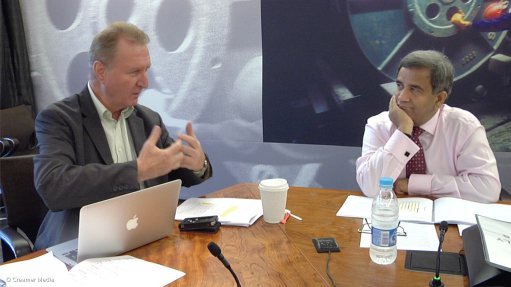
Venkat (right) and Martin Creamer
Photo by: Creamer Media
JOHANNESBURG (miningweekly.com) – Gold major AngloGold Ashanti said on Monday that the idea of the company building its own power stations to provide electricity to its South African gold mines did not pass economic muster and was thus not at the top of its current priority list.
At a media roundtable ahead of the presentation of yearly results, AngloGold Ashanti CEO Srinivasan (Venkat) Venkatakrishnan told Creamer Media’s Mining Weekly Online that the industry, together with Eskom and the government, needed to arrive at long-term solutions for the price of electricity, which had doubled in five years as a percentage of total operational costs.
“Certainly, at this stage, from everything we’ve looked at in building our own power stations - we continue to evaluate those options - those things actually don’t deliver the return or the outcome that we expect.
“We do have standby generator sets that really kick in for safety reasons when we need to evacuate our colleagues from underground operations,” Venkat commented.
The question of mining companies generating their own electricity sprung to the fore last week on the news that Sibanye Gold planned to build a R3-billion, 150 MW solar power installation and also undertake an in-depth investigation into the feasibility of its own coal-fired power stations contributing an additional 200 MW and 600 MW.
Sibanye complained at its latest presentation of results that operational disruption was being accompanied by high price tags, even after the company had reduced its power consumption by 20%.
Sibanye envisages self-generating in phased 50 MW stages at a site near the company’s deep-level Driefontein gold mine, which will remove 10% of its average daily reliance on the national electricity grid.
Venkat pointed out that load shedding had accentuated the need to get the best margin out of available kilowatt hours and, on a staged basis, the company intended removing supply from nonessential areas, operating its mill sequences differently, and giving priority to lower margin operations over higher margin operations.
“There needs to be a long-term solution found, but in terms of building power stations, on everything we have looked at, it didn’t actually make sense and every time we’ve looked at it, it actually shows that using power from the grid is perhaps a better solution,” he added.
The company would, however, continue to look at alternative sources of energy, particularly green energy, including solar and wind farms; but there again, for the extent to which it needed volume, it provided only standby generating capacity.